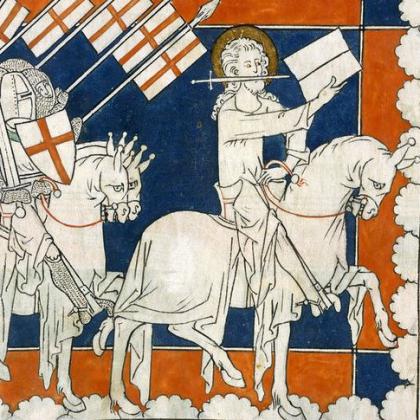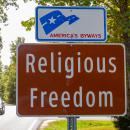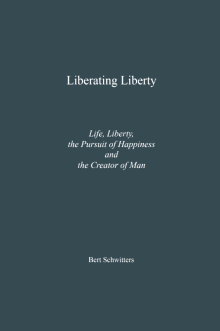If St. John of Patmos, the author of the New Testament’s Apocalypse, the Book of Revelation, could have looked down from heaven to watch the Opening Ceremony of the Paris Olympics, he might have wondered what two of the Four Horses that form part of the Revelation that was imparted to him when he was “in the spirit” were doing at the world’s most prestigeous sports event. Obviously, they were not going to compete for medals in the Olympic equestrian disciplines. In fact, one of “his” two horses would right away have been disqualified to compete for a medal, because it was an ingenious technical master-piece designed and constructed by the French atelier BLAM. ([i]) And, in terms of Olympic medals, the atelier’s artificial horse wasn’t made of Olympian gold, silver or bronze, but of … iron. Although made of iron, it magically withstood the laws of gravitation when, during the Opening Ceremony, it galloped in Christ-like manner across the waters of the river Seine.
A symbol of “peace, solidarity and unity”
The Iron Horse was an Olympian gift from the French pharmaceutical giant Sanofi-Winthrop. ([ii]) According to Sanofi, Thomas Jolly, the Artistic Director of the Games’ Opening Ceremonies, “wanted to bring out a galloping horsewoman launched up the Seine, symbolizing the entire route of the world’s delegations, and embodying all the values of Olympism.” Jolly’s artificial horse, so Sanofi, must be understood as a “symbol of resilience, peace, solidarity and unity”. Embodying “the values that have been at the heart of the partnership between Sanofi and Paris 2024”, this powerful symbol “is also the result of the know-how and spirit of scientific and artistic innovation […]”. Underlining the undying importance of Sanofi’s contribution to the Games and mankind, Paul Hudson, the company’s definitely British Chief Executive Officer, stressed how “the opening ceremony of the Olympic Games Paris 2024 showed the world French cultural audacity”, wherefore “the horse that rode up the Seine will remain one of its most striking symbols.” Honouring the value of “openness to the world”, the Iron Horse will outlast the Paris Olympics since it will be on display at La Maison Sanofi, the company’s global headquarters in Paris, from October 2024.
The Iron Horse is the Pale Horse
Well, so far, so good. Yet, given the very audacious and sometimes intentionally provocative nature of most of the Ceremony’s “acts”, one may wonder if that’s all there is to the Iron Horse and how St. John might have found out that the Iron Horse represented one of “his” horses. Scrolling through Sanofi’s Olympic Ceremony webpage, visitors are invited to open various embedded youtubed videos illustrating and commenting on the event’s highlights. In one of these videos, a certain Astromeda draws the viewers’ attention to the fact that the colour of Thomas Jolly’s iron Jumper is pale. Astromeda then emphatically confirms that the Pale Horse “that we witnessed during the Olympic Games opening ceremony” is indeed “one of the four horses described in the Book of Revelation”. ([iii]) According to Astromeda, each of the four horses “represents a different aspect of the end times”. The Pale one is “often used to convey messages about mortality, transformation in the fragility of life”. Answering the rhetorical question “why was this symbolism used at the Olympic Games”, she replies that the Pale Horse “could represent the challenges humanity faces especially in light of recent global events. It’s a reminder of the resilience and strength needed to overcome adversity.” Portrayed as a “blend of ancient mythology and contemporary context” it “could be tied to celestial events”. This “astrological context adds another layer of meaning to the ceremony, emphasizing themes of resilience and renewal.” Astromeda ends her video by kindly asking its viewers “what do you think about the Pale Horse’s appearance at the Olympics?”
The horse represents Man’s intelligence
Yes. Good question indeed. What to think of the Horse’s appearance? To answer that question, allow me to suggest that we consult the German anthroposophist, erudite theologian and co-founder of the Christian Community, Emil Bock (1895 – 1959). In 1951, Bock published an in-depth clarification of the true meaning of the Book of Revelation, his book bearing the same title: Apokalypse. Lending insights from Bock’s monumental work, I explained in my book Liberating liberty that the horse is to be understood as the symbol that represents Man’s intelligence. In the Apocalypse, there appeared four horses that were to be distinguished by their colour: white, red, black and pale. By way of its colour, each horse represents a specific state of human intelligence and this state is the result of the way its Rider approaches and deals with reality. So it is that the White Horse works in full alignment with its Rider’s respect for the Laws of Nature and of Nature’s God. It produces truth and deals with the fullness of existence. The White Horse is ridden by a Rider who was given a crown and who holds a bow that he can use in aiming at his Mark. The Mark is the Biblical symbol that epitomizes Man’s highest spiritual Self. Having hit the Mark, the Rider of the White Horse overcomes the physical universe and frees himself of the self-imposed bondage that is the result of only using only his senses to create knowledge and experience truth. (Revelation 6:2)
The Red, Black and Pale Horses
In St. John’s words, the Rider of the Red Horse “was given power to take peace from the earth and to make people kill each other. To him was given a large sword.” Clearly, this Rider’s goal is to sow discord by preventing people from hitting the Mark. (Revelation 6:4) The Rider of the Black Horse “was holding a pair of scales in his hand”. This Rider is weighing and measuring material things as they make up the physical universe. In fact, and such in analogy with what is called the “quantum enigma”, the act of measuring “collapses” (materializes) the metaphysical worlds of the white and the red horses. From there on downwards, it’s no longer about creative or destructive power, but about nothing other than physical force applied in the material world. (Revelation 6:5) Eventually, on the Pale Horse, we find a Rider named Death who was followed by Hades, the God of the dead and King of the underworld. Death and Hades “were given authority over a fourth of the earth, to kill by the sword, by famine, by plague, and by the wild beasts of the earth”. (Revelation 6:8)
Changing Horses
In the setting of St. John’s Book of Revelation, a human mind’s “paleness” indicates the death of its “Rider’s” soul and his complete disconnection from and denial of the Laws of Nature and of Nature’s God. Using his “pale” mind, Death will only cause randomity, entropy and chaos. Obviously, the Rider whose name is Death cannot ride the White Horse just like that. But he can decide to turn his life around and “change horses”. For this to happen, he must first of all seek to come alive. To come alive, he must become aware of and accept the Mark as his Mark. He must then “hit” the Mark, which is situated at the heart of his spiritual self. This is how he may become the crowned Rider who can ride the White Horse. In Revelation 19, almost at the end of the Apocalypse, St. John encountered this Rider and his White Horse in the opened heaven after they had successfully completed their journey: “Now His eyes are like a flame of fire, and upon His head many diadems, having a name having been written, which no one except He Himself knows, and having been clothed with a garment having been dipped in blood. And His name is called The Word of God.”
The Olympic White Horse
Now, let’s return to the French Olympics and let’s suppose that the symbolism used in the event’s Opening Ceremony was indeed meant to reveal a deeper layer of meaning and that we are to take the prominent role of the horse in the Ceremony as a genuine and honestly intended clue that this layer of meaning is to be found in St. John’s Book of Revelation. In that case, the Ceremony took a truly “Olympic” and lastingly meaningful turn with the dramatic changement of the artificial Pale Horse for the living White Horse that made its glorious appearance at the foot of the Eiffel tower toward the end of the Ceremony. ([iv]) Seen from this perspective, while the Pale Iron Horse and its “horsewoman” may have symbolized “the entire route of the world’s delegations” by galloping down the Seine, it was the White Horse that, when it calmly and majestically strode forward toward the white slope that led up to the official Olympic podium, actually turned the sportspeople from the countries participating in the Games into its Rider’s followers. While atelier BLAM’s ingenious Iron Horse may very well be described as “the result of the know-how and spirit of scientific and artistic innovation”, it was the living, breathing and proud noblest of all animals that, by being what it was obviously intended to be, the White Horse of the Apocalypse, exemplified that, it is the true symbol of “resilience, peace, solidarity and unity”.
Noblesse olblige
As the prototypical symbol of peace, solidarity and unity, the White Horse’s plain and untouchable presence at the finale of the Opening Ceremony also conveyed a powerful yet silent indictment of the International Olympic Committee’s exclusion of all Russian sportspeople from its 2024 Games. Having regard to that “other layer of meaning” that the organizers added to the Opening Ceremony, the fact that the Olympic flag, after it had finally been placed in the care of Olympian Officialdom, was raised ….. upside down, may very well be interpreted as an Apocalyptical acknowledgment and celestial approbation of the White Horse’s silent condemnation of the “International” Olympic Committee’s politically motivated exclusion of Russian sportsmen and sportswomen. Perhaps, if Sanofi genuinely and unreservedly wants to make an honest “this side up” statement in honour of the value of “openness to the world”, it should put the living White Horse on display at La Maison Sanofi alongside its artificial Iron Horse, to acknowledge that it was the White Horse that shall be remembered as the Opening Ceremony’s most striking symbol. After all, isn’t it so that French “cultural audacity” demands the honoring of the very French saying: Noblesse oblige !!!
+ + + + + + + + +
[i] Atelier BLAM, Nantes, France. https://bl-am.fr/info-en/
[ii] See Sanofi’s website: https://www.sanofi.com/en/magazine/paris-2024-partnership/paris-2024-opening-ceremony
[iii] Astromeda; Video; The Pale horse of the Paris Olympic Ceremony; https://www.youtube.com/watch?v=l5PQ7JGdJCE








